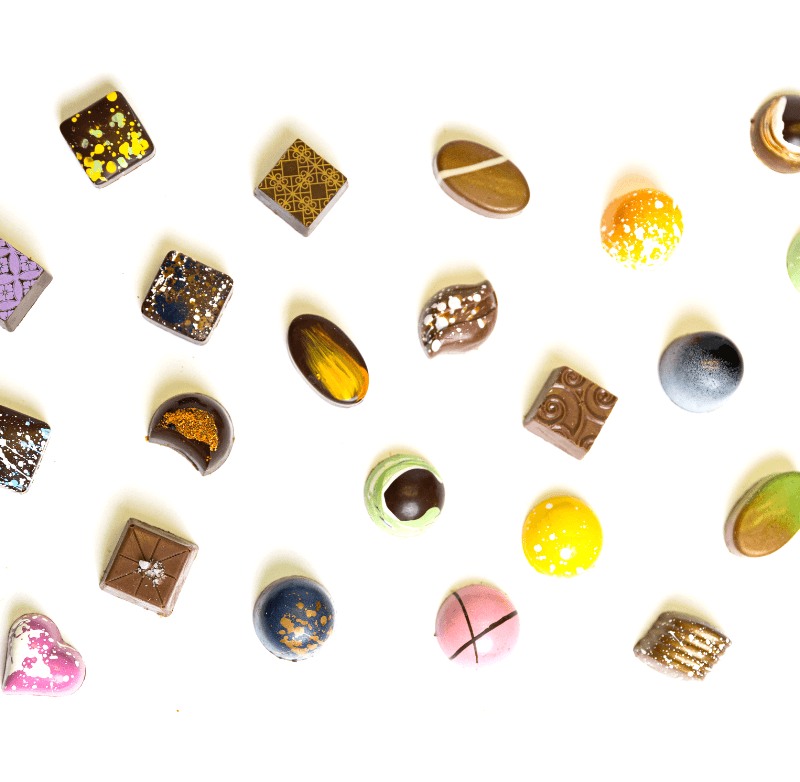The Fascinating History of Chocolate: From Ancient Civilizations to Modern Confections

Chocolate has always been more than just a delicious indulgence—it has shaped economies, ceremonies, and cultures for thousands of years. From its sacred beginnings in ancient Mesoamerican civilizations to the artisan chocolates enjoyed by modern gourmets, the story of chocolate is as rich as its flavor.
At Dallmann Confections, we believe that every chocolate truffle, bonbon, or bar should tell a story. By honoring the past while creating for the present, our handcrafted confections are part of chocolate's ongoing journey. This blog explores that journey—from wild cacao trees in the Amazon basin to premium chocolates lovingly made by artisans today.
Cacao in Ancient Mesoamerica: Where Chocolate’s Story Begins
Long before chocolate became the sweet treat we know today, it was considered divine. The cacao tree, Theobroma cacao, meaning "food of the gods," grew wild in Central and South America. Early civilizations like the Olmecs, dating back to 1500 BCE, were likely among the first to process cacao into a ceremonial drink.
Later, the Maya and Aztecs elevated cacao into something sacred. The Maya prepared a cacao-based drink known as xocolatl, made by grinding roasted cacao beans and mixing them with water, chili, and spices. This bitter, frothy beverage was a vital part of religious rituals, feasts, and royal ceremonies.
The Aztecs took cacao a step further, using its beans as a form of currency. A few beans could buy a tamale; several hundred might purchase a turkey. Cacao was reserved for warriors, nobles, and priests—those considered worthy of its energizing and spiritual properties. Montezuma II, the Aztec emperor, was said to consume large quantities of the drink daily, believing it brought him vitality and power.
Interestingly, cacao was never sweet in these ancient contexts. Sugar was unknown to these cultures. Chocolate was medicine, sustenance, and spiritual offering. It wasn’t until Europeans arrived that cacao began its transformation into the sweet treat we now crave.
The European Transformation: Chocolate Meets Sugar and Status
In the early 16th century, Spanish explorers like Hernán Cortés encountered cacao during their conquests in the New World. Recognizing its importance to Mesoamerican societies, they brought it back to Europe. However, the bitter taste didn’t align with European preferences. That changed when sugar, cinnamon, and vanilla—ingredients newly available due to global trade—were added to the mix.
Chocolate quickly became a fashionable luxury across European courts. It remained in liquid form, served hot and sweetened, often enhanced with milk. By the 17th century, chocolate was synonymous with wealth and sophistication. Chocolate salons emerged in cities like Paris and London, echoing the coffeehouses of the era but with an even more elite clientele.
Only aristocrats could afford this imported delicacy, and for over two centuries, chocolate remained a symbol of class and exclusivity. Its preparation, service, and consumption were wrapped in etiquette and grandeur.
The Industrial Revolution: The Birth of Modern Chocolate
The real democratization of chocolate began with the Industrial Revolution. Innovations in machinery and processing allowed chocolate to shift from handcrafted delicacy to mass-produced commodity.
In 1828, Dutch chemist Coenraad van Houten revolutionized chocolate-making by inventing a hydraulic press that could extract cocoa butter from roasted beans, leaving behind a dry cake that could be ground into cocoa powder. This process made chocolate more versatile, shelf-stable, and affordable.
Soon after, in 1847, British chocolatier Joseph Fry created the world’s first solid chocolate bar by reintroducing cocoa butter to sugar and cocoa powder. This simple innovation allowed chocolate to be molded, transported, and enjoyed as a portable treat.
Swiss inventors contributed further to chocolate's evolution. Rodolphe Lindt developed the conching machine in 1879, which dramatically improved chocolate’s texture, making it smooth, glossy, and melt-in-your-mouth soft. Around the same time, Daniel Peter collaborated with Henri Nestlé to create the first milk chocolate bar, further expanding chocolate’s reach and appeal.
These breakthroughs laid the foundation for global chocolate production, paving the way for household names like Cadbury, Hershey, and Nestlé to become chocolate empires.
Chocolate Goes Global: Industry, Impact, and Artisan Revival
By the early 20th century, chocolate had moved from European drawing rooms to grocery store shelves. Brands like Hershey’s and Cadbury brought chocolate into millions of homes, making it a standard part of holidays, school lunches, and everyday snacking.
But this rapid expansion also brought challenges. Today, most of the world’s cacao is grown in West Africa, particularly in Côte d'Ivoire and Ghana. While these regions provide the bulk of global supply, concerns about deforestation, child labor, and unsustainable farming practices have pushed the chocolate industry to reflect on its impact.
In response, a new movement began to take shape—the artisan chocolate revival. This shift focuses on small-batch production, direct trade with farmers, transparent sourcing, and a return to high-quality ingredients. Consumers are more informed than ever and want to know where their chocolate comes from, how it was made, and who made it.
At Dallmann Confections, we are proud to be part of this conscious chocolate movement. Our products reflect a respect for tradition and a commitment to ethical craftsmanship. Each piece we create is a celebration of flavor, history, and integrity.
The Modern Chocolate Experience: Culinary Art Meets Cultural Icon
Today, chocolate is as diverse as it is beloved. Gourmet confections have gone far beyond milk, dark, or white varieties. Now, it's common to find chocolate infused with exotic flavors like cardamom, sea salt, lavender, matcha, and chili. Single-origin chocolates showcase regional flavor notes—some fruity, others nutty, floral, or smoky—depending on the terroir where the cacao was grown.
Chocolate plays a role in countless celebrations and life events. It’s a go-to gift for anniversaries, birthdays, and holidays like Valentine’s Day and Easter. It’s also become a tool for mindfulness, self-care, and gourmet exploration.
People no longer eat chocolate simply to satisfy a craving—they seek experiences. Whether it’s a hand-painted bonbon with yuzu and black sesame, or a ganache infused with elderflower, chocolate today exists at the intersection of comfort and culinary creativity.
Dallmann Confections: Where Heritage Meets Handcraft
At Dallmann Confections, we treat chocolate with the reverence it deserves. Our chocolatiers draw from centuries of tradition while crafting modern confections that surprise and delight. We use only high-quality, ethically sourced ingredients, and every piece is made by hand with artistic precision.
Our selection includes ganaches, pralines, chocolate-covered fruits, and specialty truffles that celebrate flavor and design. We believe chocolate is an expression of emotion, memory, and joy—and every creation reflects that belief.
Whether you're enjoying a quiet moment with a dark chocolate espresso truffle or sharing a gift box during a holiday gathering, you're tasting more than chocolate. You're tasting history, culture, and craftsmanship.
Discover the Legacy of Chocolate—One Bite at a Time
Chocolate has traveled a long way from sacred altars in Mesoamerica to your dessert plate today. It has been revered, traded, industrialized, and reinvented—but through it all, it has remained a powerful symbol of pleasure and connection.
At Dallmann Confections, we are proud to be part of chocolate’s enduring legacy. Our creations honor centuries of heritage while celebrating the innovation of today. Every piece we make is more than a confection—it’s a tribute to the journey chocolate has taken through time.
Explore our artisan chocolate collection and treat yourself to a timeless indulgence made for modern palates. It’s time to taste the history behind every handcrafted piece.













